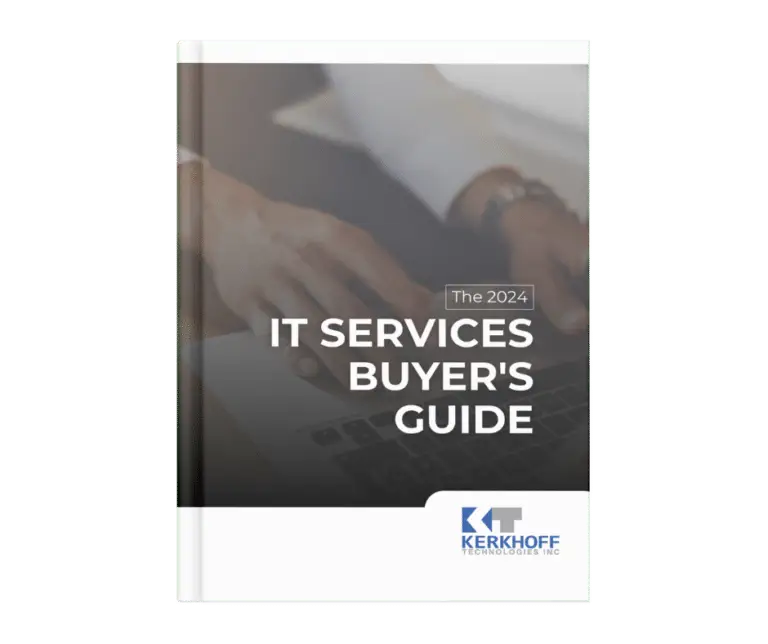
- Kerkhoff Technologies
- Business
- Your 15-Step IT Profitability Road Map For 2024
Contact Us To Schedule Your Discovery Call
Follow us on Social Media

If you’re aiming to reduce expenses and increase profits in 2024 without sacrificing productivity or efficiency, one of the initial areas to scrutinize in your business is the technology employed in your daily operations.
We’ve designed a systematic guide that allows you to methodically traverse your organization, identifying areas where you could potentially save money or leverage superior or novel technology to enhance operational efficiency.
-
Inventory of Technology
- Execute a detailed audit of your existing technology resources, encompassing hardware, software licenses, and peripherals such as monitors, printers, keyboards, etc.
- Pinpoint any obsolete or rarely used equipment that could be updated or phased out.
Software Licenses and Subscriptions
- Conduct a thorough review of all software licenses and subscriptions to ensure compliance.
- Detect any inactive or redundant software and remove unnecessary costs.
Optimization of Cloud Services
- Analyze your cloud services usage and contemplate resource optimization based on actual requirements.
- Continually monitor and adjust cloud service subscriptions to align with evolving business needs.
- Scrutinize security measures for cloud-based services to prevent data breaches. This could be a costly issue, so it’s crucial not to overlook it.
-
Energy Efficiency
- Adopt energy-saving practices, like server consolidation, use of energy-efficient hardware, and optimization of data center cooling.
- Consider virtualization to decrease the number of physical servers, thereby saving on both energy and hardware expenses.
Infrastructure for Remote Work
- Enhance remote work capabilities to accommodate flexible work arrangements. Inefficiencies here can lead to decreased productivity, inflated costs, and heightened cybersecurity risks.
- Allocate resources for secure collaboration tools and virtual private network (VPN) solutions for remote access.
Optimization of Data Storage
- Evaluate data storage needs and implement data archiving strategies to free up primary storage. Are you storing documents you don’t need? Are there redundant files that should be removed?
- Consider cloud storage options for scalability and cost-effectiveness.
-
Network Performance
- Regularly monitor and optimize network performance to ensure faster and more reliable data transfer, reduce downtime, enhance the user experience and support cost savings, ultimately contributing to the overall efficiency and success of your business operations.
- Implement quality of service (QoS) settings to prioritize critical applications and services.
IT Security Measures
- Regularly update and patch software to address security vulnerabilities.
- Ensure that antivirus, anti-malware and other security solutions are up-to-date and active.
- Conduct regular security audits and employee training to prevent security breaches.
- NOTE: This list of cyber security measures is just the tip of the iceberg. If you haven’t had a professional examine your security solutions, this needs to be a priority. Data breaches are expensive and can shut a business down. Click here to book a call with our team.
Efficiency of IT Help Desk
- Implement or optimize an IT help desk system to streamline support requests.
- Use a faster, more efficient ticketing system to track and prioritize IT issues, improving response times and resolution rates.
Management of Mobile Devices (MDM)
- Implement MDM solutions to manage and secure mobile devices used by employees.
- Enforce policies that ensure data security on company-issued or BYOD (bring your own device) devices.
Management of Vendors
- Examine vendor contracts and negotiate for improved terms, or consider other competitive alternatives.
- Where feasible, merge vendors to simplify management and potentially decrease costs.
- Assess the cyber security measures of vendors to ensure maximum data security. Remember, if they suffer a breach and your data is compromised, you’re still liable.
Training Programs for Employees
- Offer continuous training programs to boost employees’ IT skills and awareness.
- Cut down on support costs by enabling employees to resolve common issues on their own.
Hardware that is Energy-Efficient
- Invest in hardware that is energy-efficient to cut down on electricity costs and contribute to environmental sustainability.
- When replacing outdated equipment, consider upgrading to devices that are more power-efficient.
-
Initiatives for a Paperless Environment
- Investigate paperless solutions to decrease costs associated with printing and document storage.
- Establish digital document management systems for increased efficiency and cost savings.
Optimization of Telecommunications
- Evaluate telecom expenses and consider renegotiating contracts or looking into alternative providers.
- Employ Voice over Internet Protocol (VoIP) for a cost-effective and scalable communication solution.
By methodically addressing these areas, business owners can improve their IT infrastructure, boost productivity, and achieve cost savings that contribute to overall profitability. Regularly revisiting and updating this checklist will help businesses stay agile in the ever-evolving landscape of technology and business operations.
If you require assistance in implementing the action steps on this list, our team is prepared to assist. Click here to schedule a FREE 10-Minute Discovery Call with our team, where we’ll discuss your company’s needs and answer any questions you may have.

The business owner's guide to IT management
and support services
Questions you MUST ask before you hire an IT consultant and
enter into an IT service agreement.


